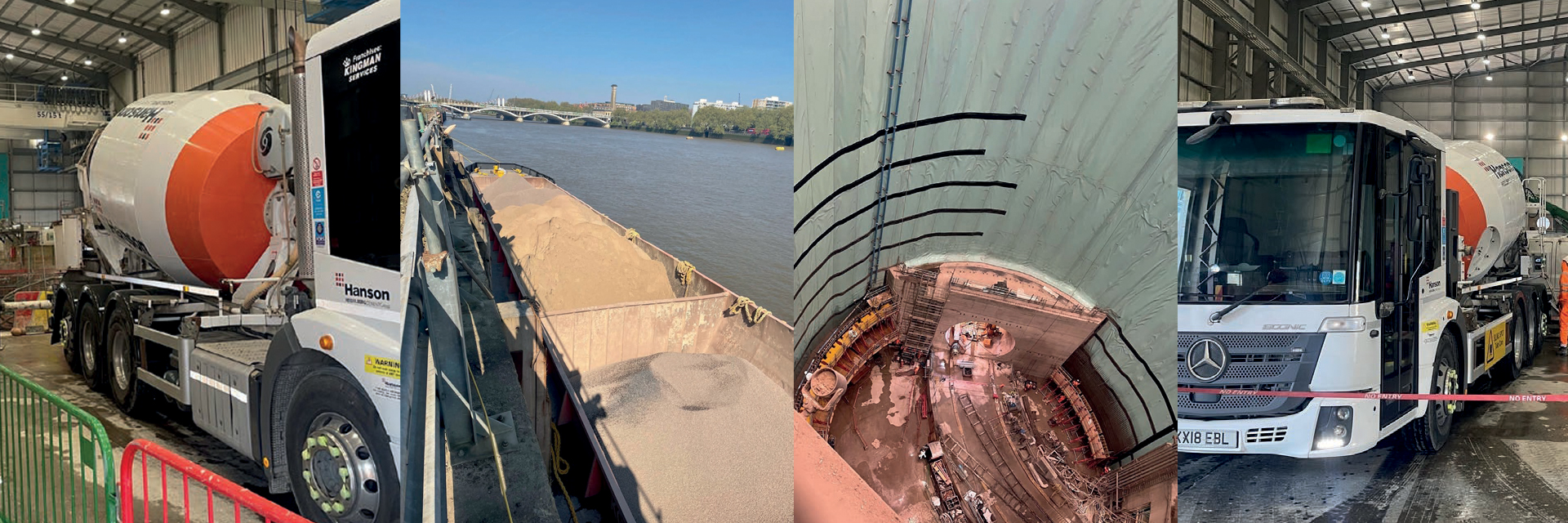Thames Tideway Tunnel central section, London
Products/volumes
120km³ of concrete for tunnel segments (primary lining) 70km³ of in-situ lining concrete (secondary lining)
Sub-contractor
FLO JV (Ferrovial Agroman and Laing O’Rourke)
Client
Thames Tideway Tunnel
Overview
Hanson has supplied the concrete used to cast the (precast) tunnel segments and provide the in-situ lining of the tunnel structure in the central section of the Thames Tideway project. Hanson also supplied the concrete for other areas of the works in central section, not covered in this case study.
Project description
The Thames Tideway Tunnel is a major infrastructure project, set to be commissioned in 2025. It is being delivered in three packages: west, central and eastern sections.
Hanson has supplied the concrete to complete the tunnel central section, which runs for 12.7km from Falconbrook Pumping Station to Blackfriars Bridge Foreshore.
London’s Victorian sewer network was designed to serve four million people. The current population is nearly nine million and estimates predict that this figure will be 16 million by 2160. As a result, the sewer system cannot cope with the current levels of effluent and surface water, which adds up to tens of millions of tonnes every year.
The Thames Tideway Tunnel is being constructed to alleviate the discharge of sewage from the current system following rain. Rather than this excess being discharged into the River Thames, it will be intercepted and discharged into the tunnel and treated in Beckton, east London, prior to discharge. Hanson supplied 120km³ of concrete used to cast the tunnel segments (primary lining) and approximately 70km³ of in-situ lining concrete (secondary lining), working closely with the supply chain to develop solutions that met all requirements.
Hanson set up a site plant at Battersea for the in-situ concrete (secondary lining) as well as a UKAS laboratory on site, with a dedicated site team, for the duration of the in-situ concrete supply. The project’s concrete specifications required a large and detailed amount of production testing to validate the concrete produced and placed. This took place on-site to assess and ensure that the required quality of the concrete was met.
Due to the end use and the extended design life (120 years) of the tunnel and the project, durability of concrete was a key design criterion, specifically controlling the chloride content of its constituents, performing specialised durability testing during the initial stage of definition and optimisation of the concrete mixes and monitoring thermal concrete differentials during construction to prevent cracking. The final (as-struck) concrete also had to meet high levels of finish standards, to ensure the boundary friction once the tunnel is in service was minimal and to keep its surface maintenance free.
The concrete specification for the in-situ lining was produced by AECOM and developed by Hanson and FLO JV. The concrete mix was driven by durability and performance and required:
- Specified cement type and replacement
- A maximum cement content
- A maximum water/cement ratio
- High compressive and flexural strengths
- Defined autogenous shrinkage and chloride ingress limits defined
- A maximum depth of carbonation
- A four-hour open life
- 12-hour striking time after placement (16 hours after batching)
Both the precast (primary lining) and in-situ concrete (secondary lining) had a compressive strength requirement of 60MPa. The precast concrete contained both micro-fibres and steel fibres, while the secondary lining concrete contains steel fibres only. There was no in-situ reinforcement used in the tunnel structure, apart from some connection zones which link the main tunnel to the various access shafts along the length of the project. For these connections, a variant of the in-situ secondary lining concrete was developed, removing the steel fibres from its composition.
Initial laboratory trials and the approvals process for the precast concrete, which established the required parameters were met, started in 2016 and the first concrete was supplied in March 2018. There was a similar lead-in period associated with the in-situ secondary lining concrete, with supply beginning in November 2020.
Over the course of the next 12 months approximately 70km³ of in-situ secondary lining material was produced, tested and placed. The shutters into which the concrete was placed were 4.5km from the Kirtling Street access shaft, working back to the pit bottom. The concrete was discharged into agitators which transported the material via railway to the shutters, where it was then pumped into place, with each pour being around 155m³. Once an appropriate strength had been achieved, the shutters were struck and moved to allow the process to be repeated.
There were two shutters in use at any one time to allow the placing of concrete 24 hours a day, seven days a week. As a result, the central tunnel section was completed four months ahead of schedule.
